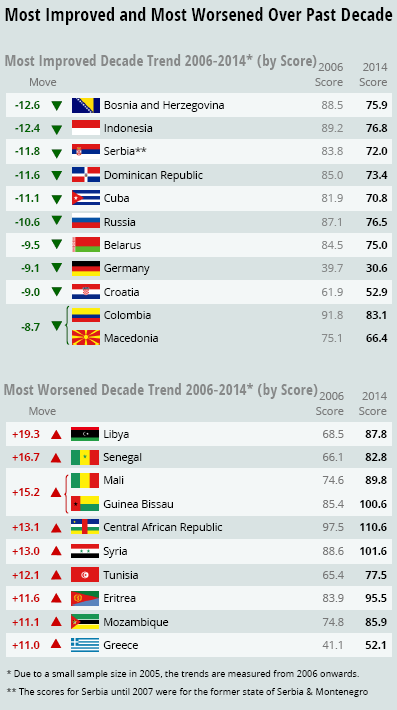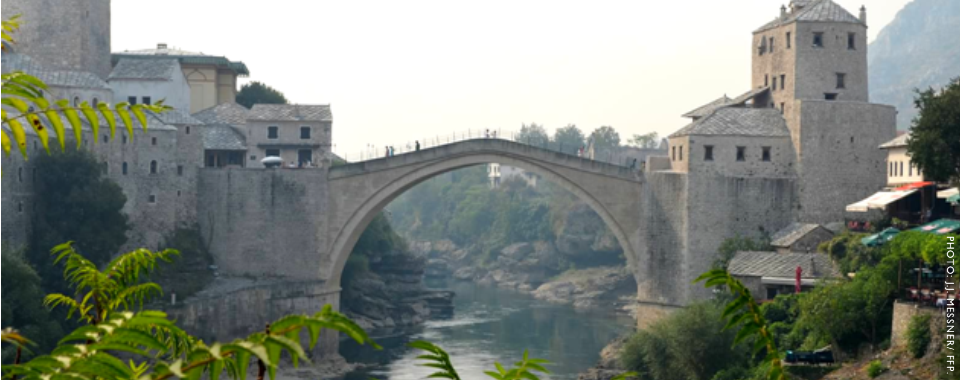BY LAURA BRISARD
Fragile States Index 2014
A decade of Fragile States Index (FSI) data gives the opportunity to focus on the parts of the world that are truly improving. Two countries nearly tied for most-improved country of the past decade: Bosnia & Herzegovina (BiH) and Indonesia.
The Fund for Peace has previously covered the promising development of Indonesia, and it would appear that this trend is continuing. However, what makes BiH especially interesting is that it is not merely one single country that is leading the charts — it’s part of an entire neighborhood of improvement.
Of the countries that have improved the most, one region of the world stands out: the Balkans and specifically, the countries of the former Yugoslavia. The breakup of Yugoslavia in 1991-1992, followed by political turmoil and bloody civil war, led to the creation of five independent states – BiH, Croatia, Macedonia, Serbia and Slovenia. After Kosovo and Montenegro declared independence from Serbia, the number of former Yugoslav countries rose to a total of seven. Out of those seven countries, four of them are among the Top 10 most improved countries of the decade – with BiH placing 1st, followed by Serbia at 3rd, Croatia at 9th, and Macedonia at 10th. Slovenia also ranked a respectable 35th-most improved. (Montenegro was only scored as a separate country beginning in 2007, and its ranking has remained steady since then; Kosovo is not included in the FSI as it is not a UN member.)
 Over the past decade, the former Yugoslav countries have experienced a steady improvement. Slovenia and Croatia are both now member states of both NATO and the EU, with Macedonia, Montenegro and Serbia having been granted candidate status for EU membership. All of the former Yugoslav countries, with the exception of Kosovo, are aspiring members of NATO, already working alongside the organization through peace programs. With the path to accession to these international bodies has come a program of political, economic and social reform, which has helped significantly in tackling core issues such as ethnic tensions, corruption and poverty. These efforts have certainly contributed to their overall score improvement in the FSI in the past decade.
Over the past decade, the former Yugoslav countries have experienced a steady improvement. Slovenia and Croatia are both now member states of both NATO and the EU, with Macedonia, Montenegro and Serbia having been granted candidate status for EU membership. All of the former Yugoslav countries, with the exception of Kosovo, are aspiring members of NATO, already working alongside the organization through peace programs. With the path to accession to these international bodies has come a program of political, economic and social reform, which has helped significantly in tackling core issues such as ethnic tensions, corruption and poverty. These efforts have certainly contributed to their overall score improvement in the FSI in the past decade.
Among the six former Yugoslav countries examined in the FSI, it is not surprising that Slovenia and Croatia have been faring better than their neighbors, ranking respectively 163rd and 136th. These two countries were the first to declare their independence from the former Yugoslavia in June 1991 and are today the only two which are members of both NATO and the EU. Another striking trend within this group of countries is the impressive trajectory of Bosnia and Herzegovina, which has become the most improved country of the decade on the Index.
In the first FSI, in 2005, BiH ranked 21st and was classified as being in the “Alert” category. In the decade since, BiH has managed to improve considerably, and although it still finds itself in the “High Warning” category with a score of 75.9, it has nevertheless improved its situation markedly, now being ranked 86th and earning the distinction of the most-improved country in the Index’s first decade.
This impressive progress, with a gain of 51 places in the rankings from 2006 to 2014 indicates how BiH is moving forward after the civil war in the former Yugoslavia that raged from 1992 to 1995. After the disintegration of the former Yugoslavia, like most of those former constituent states, the focus of BiH has shifted towards European integration. In the past ten years, Bosnia and Herzegovina has made great strides in various areas, though the areas where the FSI has measured the most significant progress has been in terms of Demographic Pressures and External Intervention. The scores for Refugees and IDPs have also improved markedly. Of some concern however is that the country’s score for Factionalized Elites has remained unchanged, and its Human Rights and Rule of Law score has actually worsened. Nevertheless, all other indicators have shown improvement.
BiH is frequently confronted with natural calamities, with floods and extreme temperatures, so the improvement in the country’s Demographic Pressures indicator score may be somewhat surprising. This is a reflection of the country’s improvements in human metrics such as life expectancy, a decline in child mortality and general overall health improvements, especially among the young. Other key social metrics, such as adult literacy, have also improved. Meanwhile, the country appears to be on track to reach its goal of achieving universal primary education by 2015, with an additional significant increase of the enrollment in secondary school and higher education. Better access to drinking water and to the sewage system has further helped enhance the living conditions of the Bosnian population.
The 1995 Dayton Peace Agreement, which put an end to the conflict and implemented the current division of BiH into three entities — the Federation of Bosnia and Herzegovina, the Republika Srpska and the Brčko District — established UN supervision of the implementation of the peace process, a role that it still performs today. Besides this supervision, various NATO- and European-led peacekeeping missions were deployed. From early 2005 however, the number of troops has decreased every year — in 2009 there were around 2,200 troops and by 2012 this number was down to 1,300. Foreign assistance has focused on issues related to governance, institutions and financial governance, mostly through financial assistance offered by the IMF, the World Bank or the EU. Recovery from conflict, and the drawdown in international intervention that accompanied it, has contributed heavily to the improvements in BiH’s External Intervention score. Today, BiH relies less on foreign assistance than it formerly did.
The issue of refugees and internally displaced persons (IDPs) is still a current concern in BiH. However, the volume of refugees and IDPs has greatly decreased over the past decade. In contrast, the number of returnees increased for a few years before slowing down and decreasing, proving that a significant number of former refugees and IDPs have felt it safe to return to their homes. In 2007, there were about 3,600 returnees, in 2008; it had increased to 7,600. Considering the conflict ended almost 20 years ago, issues related to refugees and IDPs are not as urgent as they were in the years following the civil war. Notwithstanding, it was estimated that around 8,600 people still live in one of the 159 collective centers throughout BiH in 2012, proving that such issues are still current, even if the refugee and IDP situation in the country has improved overall.
Despite this remarkable improvement, BiH still faces many challenges, mainly remnants of its civil war. Peace-building and reconciliation processes are as important today as ever as the prosecution of war criminals has been too slow, a lack of reparations for civilian victims of war crimes, and many enforced disappearances which have yet to be resolved. The divisions between the three main ethnicities which make up the country (Bosniaks, Croats and Serbs) are still an important issue. Further, smaller ethnic groups are not even represented politically. BiH is additionally the most landmined country in Europe. Corruption continues to be widespread in public offices. Also, despite being the most improved country over the decade, BiH remains the most fragile country among the six former Yugoslav countries included in the FSI.
The overall improvement of BiH since our first FSI was published in 2005 is striking because it displays the possibilities for conflict-affected states to progress and to overcome their challenges. BiH has evolved from a post-conflict country, under quasi-total international supervision, in which everything needed to be rebuilt, to a country which may soon be on the verge of joining the European Union and NATO.
